This article has been reviewed according to Science X's editorial process and policies. Editors have highlighted the following attributes while ensuring the content's credibility:
fact-checked
reputable news agency
proofread
California's rainy season is here. What does it mean for water supply?
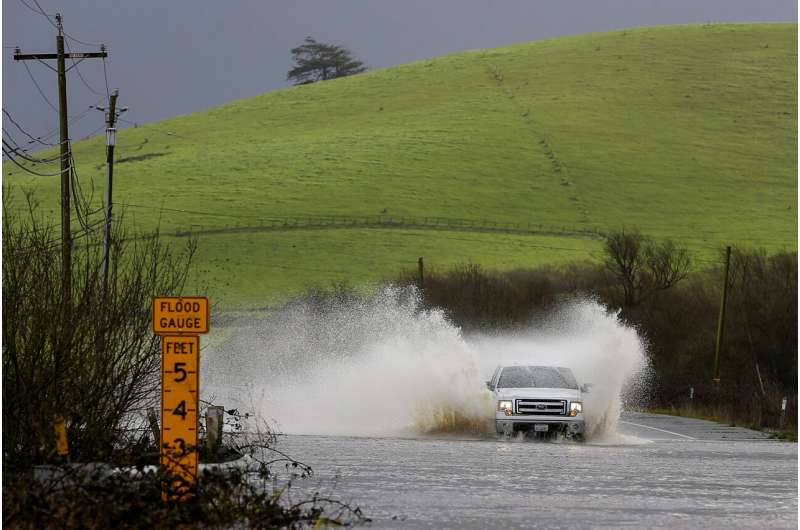
After a dry start to winter, California's rainy season is finally well under way.
December downpours sent water racing through streets in coastal Ventura County and the city of Santa Barbara. Flash floods hit San Diego in late January, and back-to-back atmospheric river-fueled storms arrived earlier this month, causing wind damage in Northern California and hundreds of mudslides in Los Angeles. Yet another storm blew through over Presidents Day weekend.
The frequent deluges have fended off a return to the drought that has plagued the state over the past decade. Some parts of California are so wet these days that even Death Valley National Park has a lake big enough for kayakers. Still, the state is not on pace for a repeat of last year's epic rain. And the mountains haven't seen nearly as much snow.
Here's a look at California's winter so far:
Has all this rain helped?
Downtown Los Angeles has received nearly 17.8 inches (45.2 centimeters) of rain, already more than an entire year's worth of annual precipitation, which is measured from Oct. 1 to Sept. 30 of the following year. This is now the fourth-wettest February in downtown since since weather records began in 1877, according to the National Weather Service.
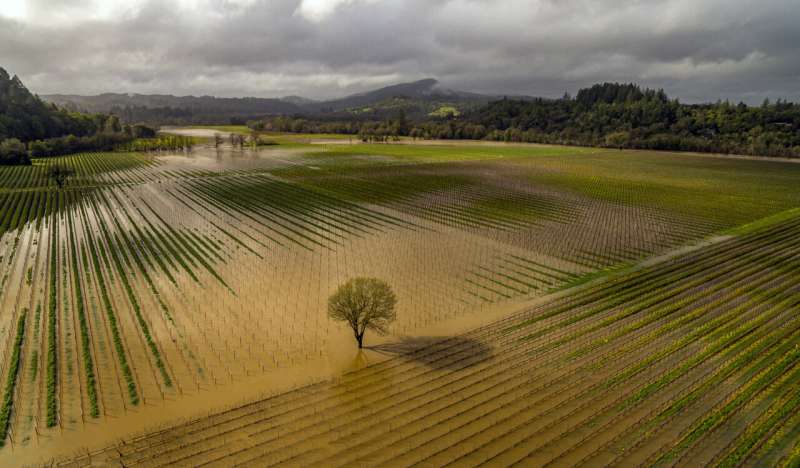
But while rainfall has reached historic levels in Southern California, it remains to be seen if the year will be regarded as very wet for the state overall.
Northern California is only just approaching its annual average, with about a month and a half to go for the wet season, which "makes it very hard to get 'extremely wet,' " said Jay R. Lund, vice-director of the Center for Watershed Sciences at the University of California, Davis.
"We're already wet enough that it's not going to be a deep drought year, and the really wet years, they are already much wetter than this," Lund said.
What about snow?
The vital Sierra Nevada snowpack, which normally supplies about 30% of California's water when it melts, has rebounded somewhat from a slow start.
The snowpack's water content Wednesday was 86% of normal amounts to date and 69% of the April 1 average, when it is normally at its peak, according to the state Department of Water Resources.
On Jan. 30, the water content was just 52% of the average for that date—a far cry from a year earlier when it was around 200% of its average content, thanks to repeated atmospheric rivers that dramatically ended California's driest three-year period on record.
-
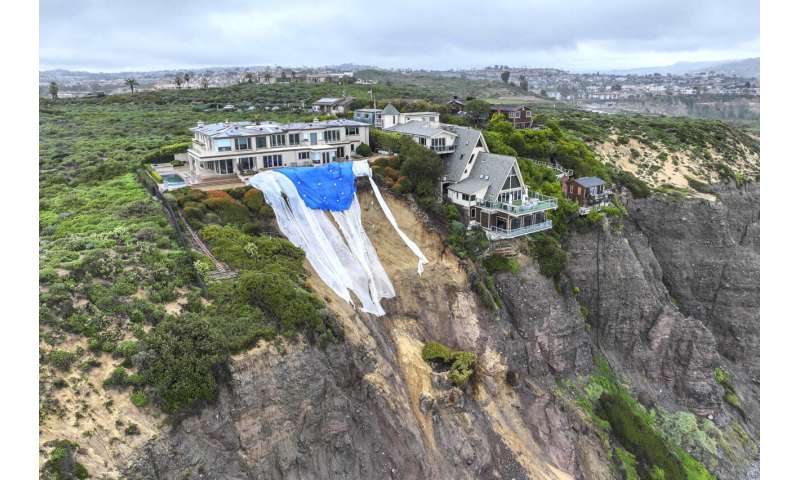
Tarps hang behind a cliff-top home above a landslide along Scenic Drive in Dana Point, Calif., on Feb. 20, 2024. California's current rainy season got off to a slow start but has rebounded with recent storms that have covered mountains in snow and unleashed downpours, flooding and mudslides. The water content of the vital Sierra Nevada snowpack has topped 80% of normal to date while downtown Los Angeles has already received more than an entire year's average annual rainfall. Credit: Jeff Gritchen/The Orange County Register via AP -
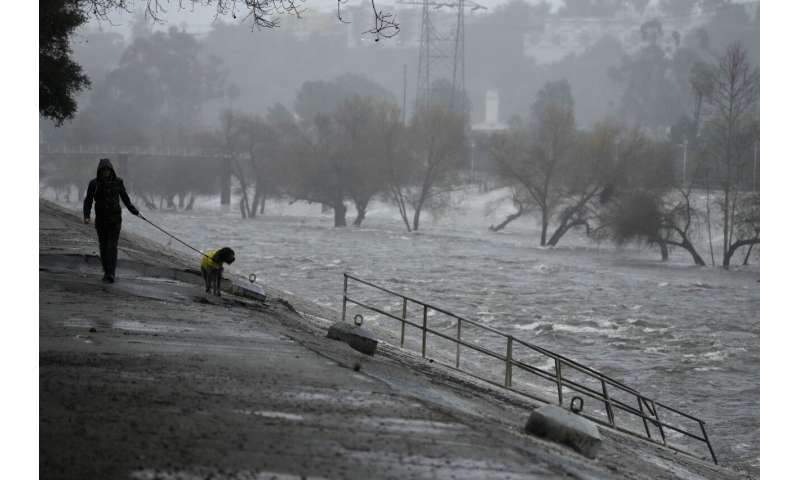
A man walks his dog on the edge of the Los Angeles River, carrying stormwater downstream on Feb. 4, 2024, in Los Angeles. California's current rainy season got off to a slow start but has rebounded with recent storms that have covered mountains in snow and unleashed downpours, flooding and mudslides. The water content of the vital Sierra Nevada snowpack has topped 80% of normal to date while downtown Los Angeles has already received more than an entire year's average annual rainfall. Credit: AP Photo/Damian Dovarganes, File -
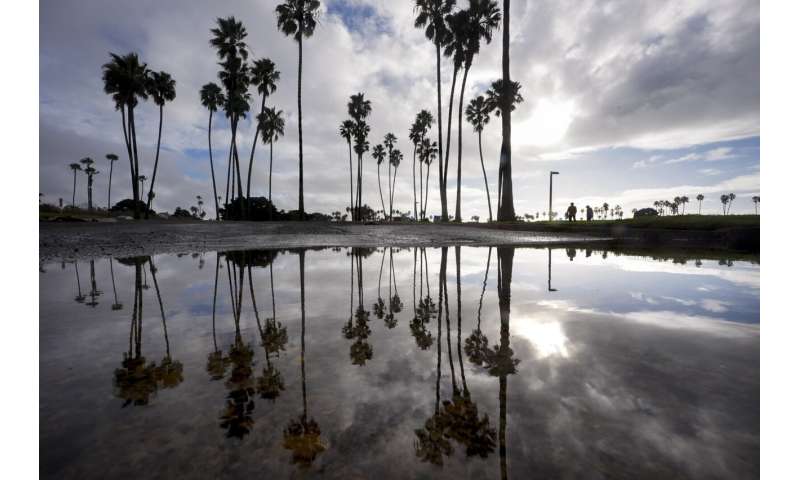
Two people walk along Mission Bay during a break in the rain on Feb. 1, 2024, in San Diego. California's current rainy season got off to a slow start but has rebounded with recent storms that have covered mountains in snow and unleashed downpours, flooding and mudslides. The water content of the vital Sierra Nevada snowpack has topped 80% of normal to date while downtown Los Angeles has already received more than an entire year's average annual rainfall. Credit: AP Photo/Gregory Bull, File -
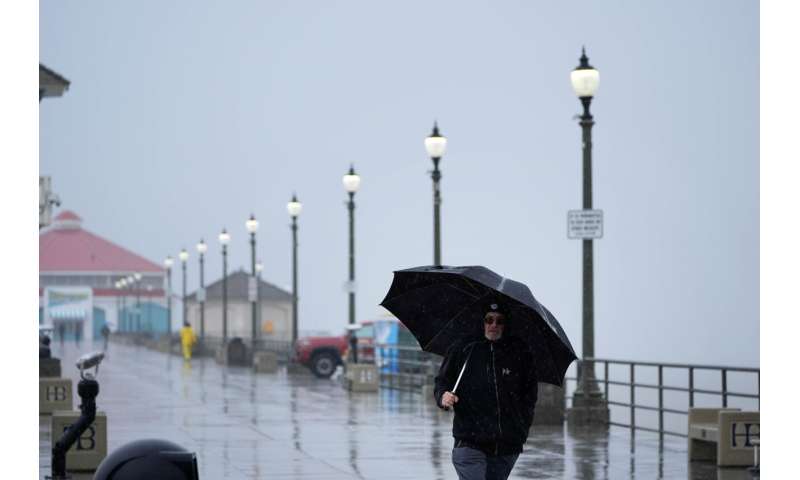
A man shields himself from the rain as he walks along the Huntington Beach Pier on Feb. 6, 2024, in Huntington Beach, Calif. California's current rainy season got off to a slow start but has rebounded with recent storms that have covered mountains in snow and unleashed downpours, flooding and mudslides. The water content of the vital Sierra Nevada snowpack has topped 80% of normal to date while downtown Los Angeles has already received more than an entire year's average annual rainfall. Credit: AP Photo/Marcio Jose Sanchez, File -
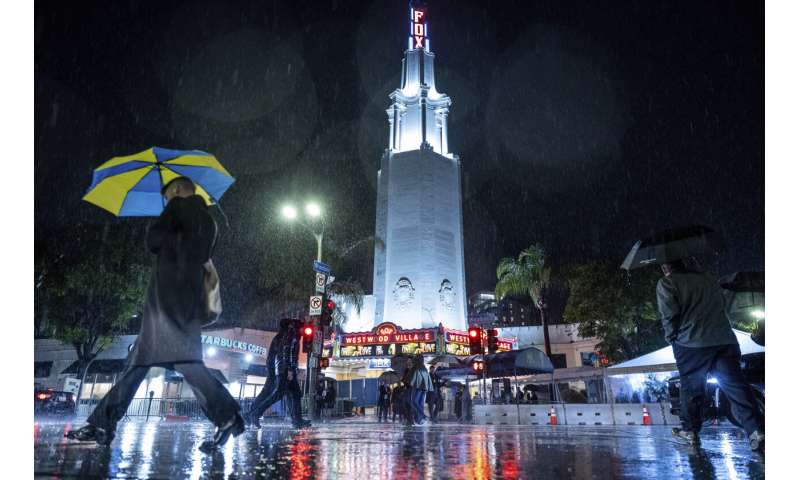
People walk in the rain past the Fox Theater on Feb. 6, 2024, in the Westwood area of Los Angeles. California's current rainy season got off to a slow start but has rebounded with recent storms that have covered mountains in snow and unleashed downpours, flooding and mudslides. The water content of the vital Sierra Nevada snowpack has topped 80% of normal to date while downtown Los Angeles has already received more than an entire year's average annual rainfall. Credit: AP Photo/Ethan Swope, File -
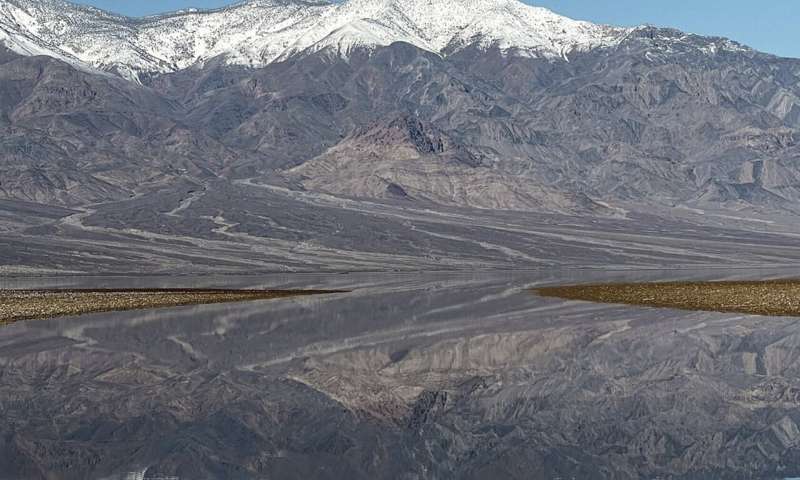
In this photo released by the National Park Service, is a lake created at Badwater Basin in Death Valley National Park, Calif., on Feb. 12, 2024. The lake was largely created by remnants of Hurricane Hilary in late August and a powerful atmospheric river early this month, according to the National Park Service. California's current rainy season got off to a slow start but has rebounded with recent storms that have covered mountains in snow and unleashed downpours, flooding and mudslides. Credit: K. Skilling/National Park Service via AP -
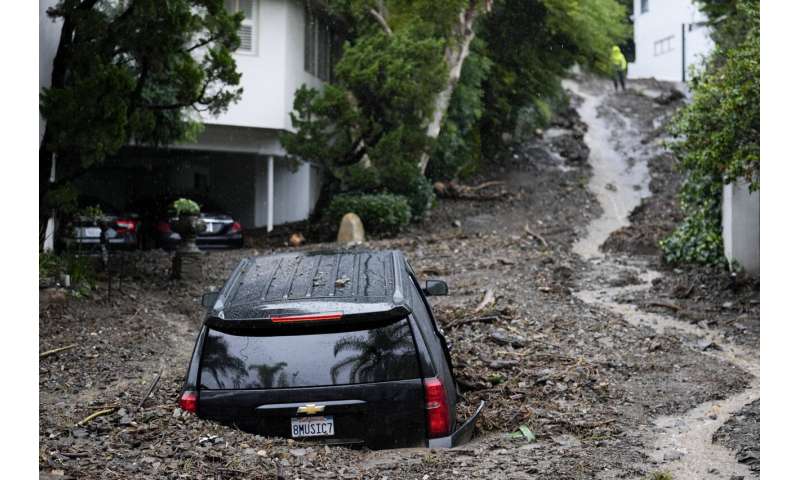
An SUV sits buried by a mudslide on Feb. 5, 2024, in the Beverly Crest area of Los Angeles. California's current rainy season got off to a slow start but has rebounded with recent storms that have covered mountains in snow and unleashed downpours, flooding and mudslides. The water content of the vital Sierra Nevada snowpack has topped 80% of normal to date while downtown Los Angeles has already received more than an entire year's average annual rainfall. Credit: AP Photo/Marcio Jose Sanchez, File -
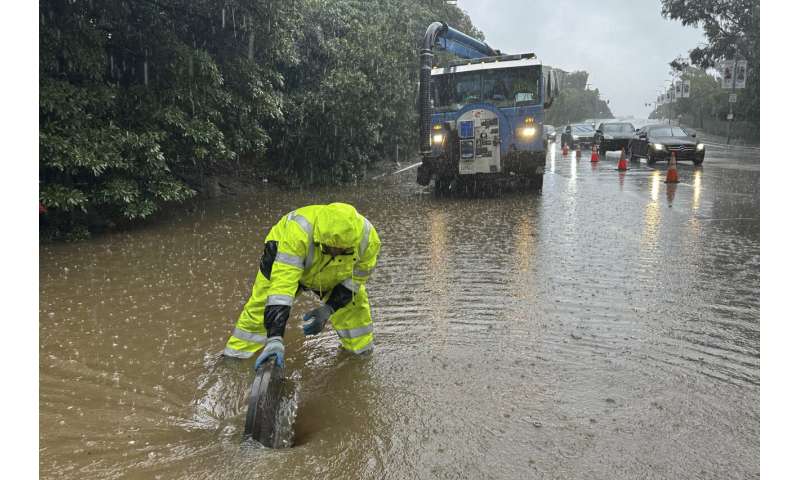
A whirlpool forms around a city worker in the Holmby Hills neighborhood of Los Angeles as he lifts a manhole cover to clear street flooding on Feb. 5, 2024. California's current rainy season got off to a slow start but has rebounded with recent storms that have covered mountains in snow and unleashed downpours, flooding and mudslides. The water content of the vital Sierra Nevada snowpack has topped 80% of normal to date while downtown Los Angeles has already received more than an entire year's average annual rainfall. Credit: AP Photo/Eugene Garcia, File -
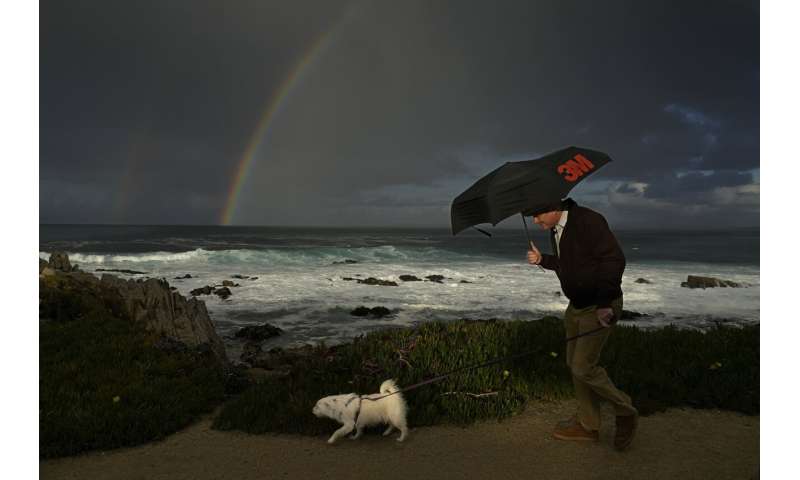
A man huddles under an umbrella as he walks a dog along the shoreline at Pacific Grove, Calif., on Feb. 2, 2024. California's current rainy season got off to a slow start but has rebounded with recent storms that have covered mountains in snow and unleashed downpours, flooding and mudslides. The water content of the vital Sierra Nevada snowpack has topped 80% of normal to date while downtown Los Angeles has already received more than an entire year's average annual rainfall. Credit: AP Photo/Rich Pedroncelli, File -
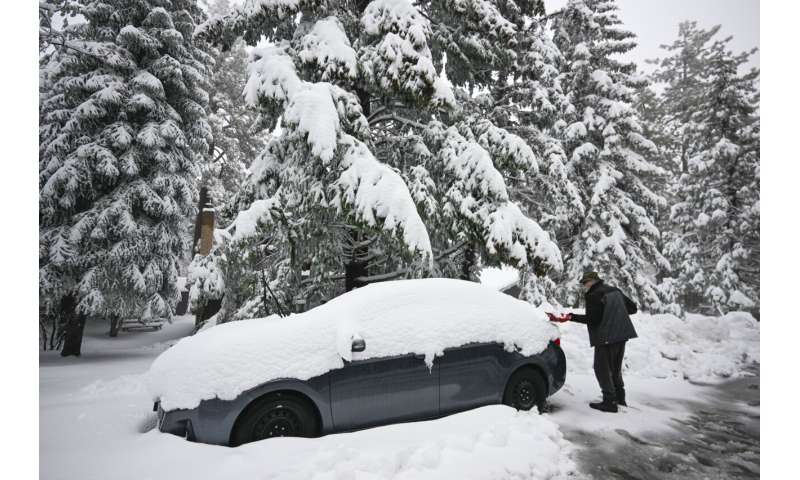
A man shovels snow off his car in the Cleveland National Forest, on Feb. 7, 2024, in eastern San Diego county, Calif. California's current rainy season got off to a slow start but has rebounded with recent storms that have covered mountains in snow and unleashed downpours, flooding and mudslides. The water content of the vital Sierra Nevada snowpack has topped 80% of normal to date while downtown Los Angeles has already received more than an entire year's average annual rainfall. Credit: AP Photo/Denis Poroy, File -
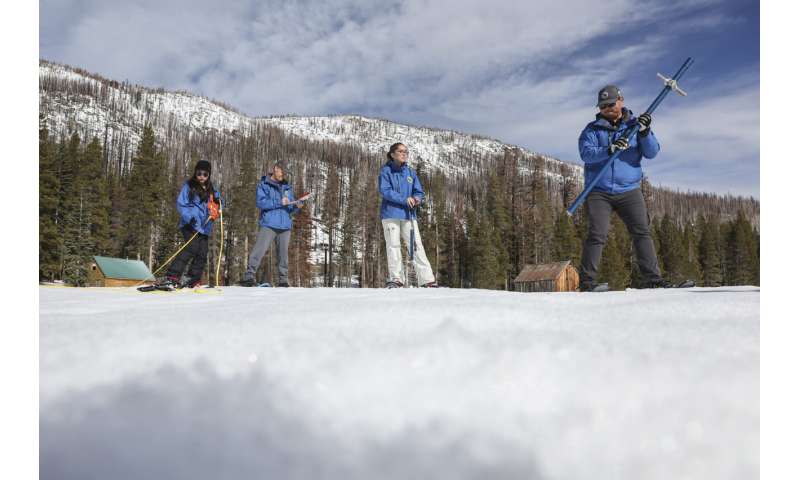
In this photo provided by the California Department of Water Resources, manager Sean de Guzman, right, prepares to insert the aluminum snow depth survey pole into the snow during the second survey of the season at Phillips Station, Calif., on Jan. 30, 2024. California's current rainy season got off to a slow start but has rebounded with recent storms that have covered mountains in snow and unleashed downpours, flooding and mudslides. Credit: Xavier Mascareñas/California Department of Water Resources via AP, File
Were reservoirs replenished?
Even with the laggard start to the current rainy season, water storage in California's major reservoirs has been well above average thanks to runoff from last year's historic snowpack.
Some reservoirs have been releasing water into rivers to make room for incoming storm runoff and maintain flood control protection for downstream areas.
The Department of Water Resources announced Wednesday that the State Water Project is forecasting that public water agencies serving 27 million people will receive 15% of requested supplies, up from December's initial 10% allocation.
The department said that the assessment doesn't include the impact of storms this month, and the allocation could be further revised in mid-March.
Lake Oroville, the State Water Project's largest reservoir, was at 134% of its average amount to date, but the department noted that the Northern California headwaters of the State Water Project saw below-average precipitation from storms over the past two months.
Contractors of the Central Valley Project, a federally run system that supplies major farming districts, will also receive 15% of their requested water supplies, federal authorities said Wednesday. That could change with more storms.
© 2024 The Associated Press. All rights reserved. This material may not be published, broadcast, rewritten or redistributed without permission.





















